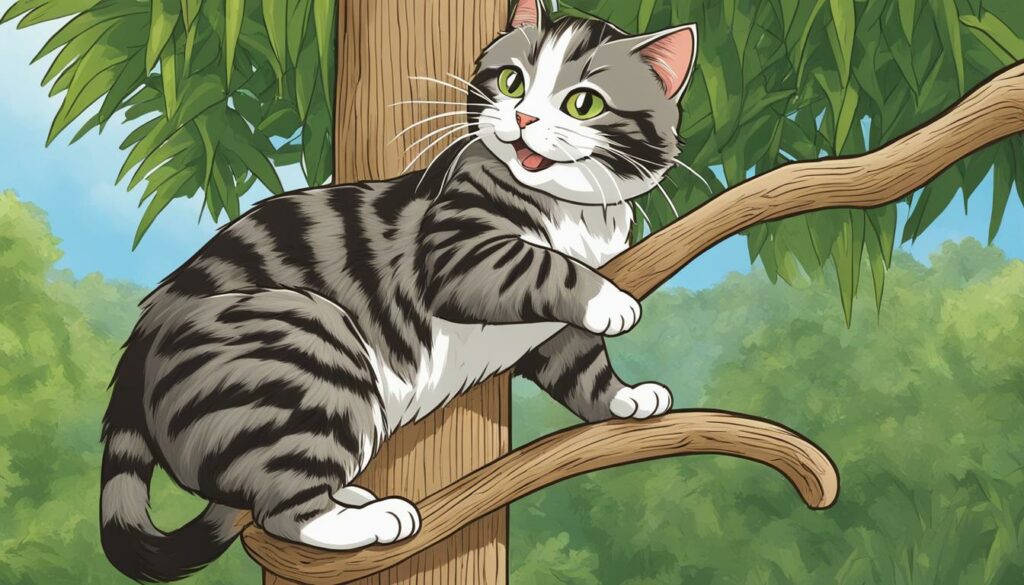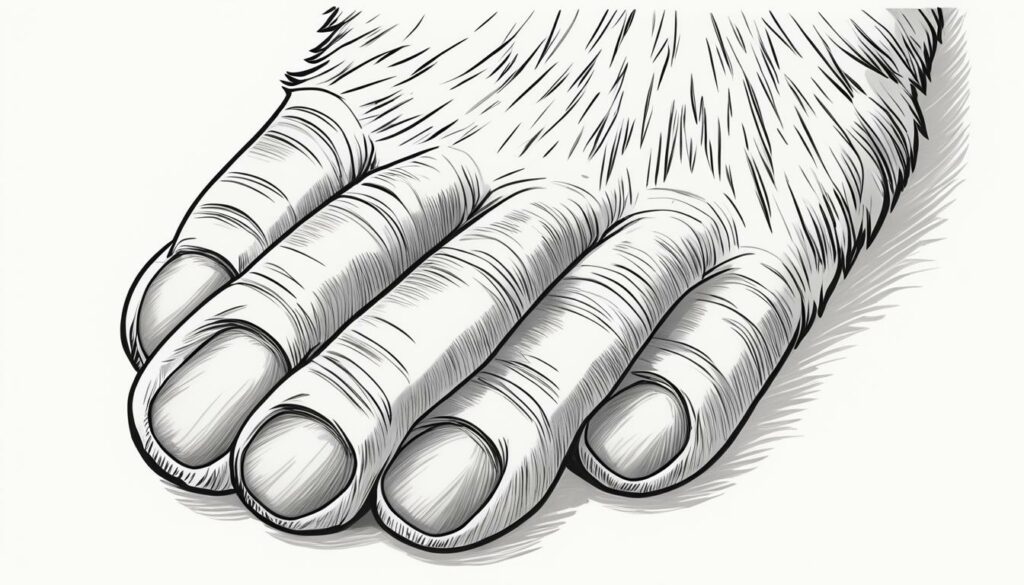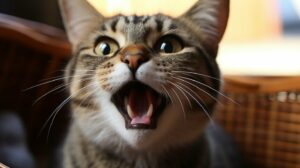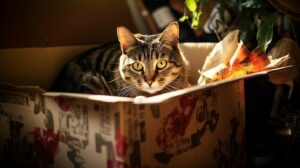Hello, cat lovers! Today, I want to introduce you to the fascinating world of cat breeds with special abilities. These unique felines possess extraordinary skills that set them apart from other breeds. From polydactyl cats with their extra toes to high-jumping breeds, these cats showcase talents that will amaze and delight you.
Let’s start with polydactyl cat breeds. These cats have more than the usual number of toes, giving them a charming and distinctive appearance. With extra toes on their paws, they demonstrate remarkable dexterity and agility. On the other hand, high-jumping cat breeds are known for their incredible leaping abilities. These athletic felines can soar to impressive heights, showcasing their natural talent and grace.
Key Takeaways:
- The unique characteristics of polydactyl cats make them highly sought after by cat lovers.
- Cat breeds with special abilities, such as jumping cats, captivate the attention and admiration of feline enthusiasts.
- Polydactylism in cats results in extra toes, adding to their charm and uniqueness.
- Athletic cat breeds exhibit exceptional jumping skills, showcasing their agility and athleticism.
- Exploring the world of cat breeds with special abilities reveals remarkable talents and skills.
The Fascinating World of Polydactyl Cats
Polydactyl cats, also known as extra toes cats, are a unique and fascinating breed. They have more than the usual number of toes on their paws, ranging from four to seven toes on each foot. The extra toes can be found on the inner side of the paw (preaxial), in the middle of the foot (mesoaxial), or on the outer side of the paw (postaxial).
The genetics of polydactyl cats involve a mutation in the Sonic Hedgehog gene, which controls the development of toes. This mutation leads to the formation of extra toes and is inherited in a dominant manner. This means that if a cat has a polydactyl parent, it is more likely to have extra toes as well. However, not all kittens from polydactyl parents will be born with extra toes, as the inheritance pattern can be variable.
Polydactyl cats are generally healthy and have no major health concerns directly related to their extra toes. However, there may be some considerations when it comes to nail trimming and grooming. The extra toes can make it challenging to trim the nails correctly, and there is a higher risk of accidentally cutting the quick. It is important to be cautious and use proper techniques or seek professional help to avoid any injuries.
“Polydactyl cats have a unique appearance that sets them apart from other cats, and their extra toes can be a fascinating conversation starter.”
Famous polydactyl cats have contributed to the popularity of this unique breed. One notable group of polydactyl cats resides at the Hemingway House in Key West, Florida. The cats at the Hemingway House are descendants of a polydactyl cat named Snow White, who was given to Ernest Hemingway by a ship’s captain. These cats have become a major attraction, and their presence adds to the charm and allure of the Hemingway House.
| Types of Polydactyl Cats | Location of Extra Toes |
|---|---|
| Preaxial polydactyl | Inner side of the paw |
| Mesoaxial polydactyl | Middle of the foot |
| Postaxial polydactyl | Outer side of the paw |
Polydactyl cats continue to capture the fascination and admiration of cat lovers worldwide. Their unique physical traits and intriguing genetics make them a truly remarkable breed.
Marvelous Jumping Cat Breeds
Some cat breeds possess extraordinary jumping abilities, showcasing their athleticism and agility. These unique felines stand out among other breeds, mesmerizing cat lovers with their impressive leaps and bounds. While not all jumping cats are polydactyls, their additional toes may contribute to their overall athleticism and enhance their balance.
One notable jumping cat breed is the Abyssinian. These elegant cats are known for their exceptional leaping skills, often reaching impressive heights in pursuit of their playful instincts. With their muscular bodies and long limbs, Abyssinians are natural-born jumpers, effortlessly navigating their surroundings with grace and precision.
Oriental Shorthair
Another athletic cat breed, the Oriental Shorthair, has a keen sense of curiosity and a knack for acrobatics. These agile cats possess long, lean bodies that allow them to effortlessly propel themselves through the air. With their slender frames and boundless energy, Oriental Shorthairs excel at vertical jumps and can often be found scaling furniture and leaping onto high surfaces.
Maine Coon
The Maine Coon breed, known for their large size and gentle nature, surprises many with their impressive jumping abilities. Despite their robust build, these majestic cats can leap to astonishing heights, showcasing their agility and strength. Their muscular hind legs give them the power to propel themselves effortlessly, making them excellent jumpers and climbers.
One cannot overlook the Bengal breed when discussing jumping cat breeds. Bengals are known for their wild and exotic appearance, and their athleticism matches their striking looks. With their muscular bodies and strong hindquarters, Bengals are capable of incredible vertical jumps, mimicking their wild ancestors and captivating onlookers with their daring leaps.
The athleticism and jumping abilities of these cat breeds are truly marvelous. Whether it’s the Abyssinian’s graceful leaps, the Oriental Shorthair’s acrobatics, the Maine Coon’s surprising agility, or the Bengal’s wild prowess, these feline athletes showcase their unique talents and leave us in awe.
The History and Folklore of Polydactyl Cats
Polydactyl cats have a rich history and captivating folklore that surrounds them. In the past, these unique felines were commonly found aboard ships, where their extra toes were believed to provide better balance during rough seas. Sailors considered polydactyl cats to be good luck charms, bringing protection and prosperity to their vessels.
“The extra toes of polydactyl cats were thought to be a divine gift, granting them exceptional climbing and hunting abilities at sea.”
The presence of polydactyl cats on ships also served a practical function. They were highly valued for their remarkable skill in keeping ships free from pesky rodents, safeguarding food supplies and preventing the spread of disease. Their adept hunting instincts and agile paws made them indispensable companions on long voyages.
“Polydactyl cats were the unsung heroes of the sea, silently guarding and protecting sailors from the perils of the deep.”
The renowned writer, Ernest Hemingway, played an influential role in popularizing polydactyl cats. Hemingway developed a deep fondness for these extraordinary felines and kept a beloved polydactyl cat named Snowball at his Key West home. He even referred to his polydactyl cats as his “six-toed geniuses.” Today, many polydactyl cats residing at the Hemingway House Museum continue to honor their famous ancestor.
“Ernest Hemingway’s fascination with polydactyl cats elevated them to the status of literary celebrities, drawing admirers from around the world.”
The allure of polydactyl cats extends far beyond their historical significance. These captivating cats have become a symbol of strength, luck, and companionship. Their enchanting stories and unique physical features have inspired numerous myths, legends, and even works of art. The history and folklore surrounding polydactyl cats have left an indelible mark on our fascination with these exceptional felines.
| Historical Significance | Folklore and Beliefs |
|---|---|
| Polydactyl cats on ships | Extra toes as good luck charms |
| Exceptional hunting abilities | Divine gifts and protection at sea |
| Hemingway’s influence | Polydactyl cats as literary celebrities |
| Inspiration for myths, legends, and art |
Exploring the Genetic Anomalies in Cats
Polydactyl cats are not the only cat breed with unique genetic anomalies. Cats can have various genetic mutations that result in physical traits such as short tails or folded ears.
One example is the Manx cat, which has a naturally occurring genetic mutation that causes them to have either no tail or a short tail. This anomaly adds to their distinctive appearance.
The Scottish Fold cat is another breed with a genetic mutation that gives them folded ears. This trait sets them apart and adds a touch of charm to their overall appearance.
In addition to these anomalies, there is dwarfism, a genetic condition that can result in cats with short legs. These dwarf cats may have a different gait but are just as lovable and playful as their normal-sized counterparts.
These genetic anomalies in cats contribute to the diversity and fascination of the feline world. They showcase the incredible range of genetic variations that can occur in cats, making each one unique and special in their own way.
| Genetic Anomaly | Breed |
|---|---|
| Short tail | Manx |
| Folded ears | Scottish Fold |
| Dwarfism | Various breeds |
Are Polydactyl Cats Rare?
Polydactyl cats are not as rare as one might think. While not all cats have extra toes, polydactyly is a relatively common genetic trait. The occurrence of polydactylism can vary among different cat breeds, with some breeds having a higher incidence than others. However, it is not limited to specific breeds, and any cat can exhibit this unique feature. Polydactyl cats are loved and admired for their special abilities and charming appearance.
When it comes to the rarity of polydactyl cats, it’s important to understand that the term “rare” can be subjective. While they may not be as common as cats without extra toes, polydactyl cats can still be found in various locations and households. The prevalence of polydactylism in different cat breeds contributes to their overall commonness in the feline population.
To showcase the commonness of polydactyl cats, let’s explore a table highlighting the incidence of polydactylism in some popular cat breeds:
| Cat Breed | Incidence of Polydactylism |
|---|---|
| Maine Coon | Common |
| American Shorthair | Common |
| Ragdoll | Common |
| Sphynx | Rare |
| Bengal | Rare |
This table demonstrates that polydactylism is more prevalent in certain breeds like the Maine Coon, American Shorthair, and Ragdoll, while it is rarer in breeds like the Sphynx and Bengal. However, it’s important to note that these are general observations, and individual cats within a breed may or may not exhibit polydactylism.
Overall, the commonness of polydactyl cats challenges the notion of their rarity. Whether through their unique abilities or their adorable extra toes, these cats continue to capture the hearts of cat lovers around the world.
Taking Care of Polydactyl Cats
Taking care of polydactyl cats is essential for their overall health and well-being. While they may have extra toes, their needs are similar to those of other cats. Here are some tips to ensure the proper care of your polydactyl feline friend:
Nail Care for Polydactyl Cats
Regular nail trims are crucial for polydactyl cats, as their extra toes can make it challenging for them to naturally wear down their claws. Overgrown nails can cause discomfort and potential health issues.
Tip: Use cat-specific nail clippers or grinders to trim your polydactyl cat’s nails. Be careful not to trim too close to the quick, which is the sensitive part of the nail. If you’re unsure or uncomfortable with nail trimming, consult your veterinarian or a professional groomer.
Health Concerns for Polydactyl Cats
While polydactyl cats are generally healthy, their extra toes may require extra attention. Watch out for signs of any potential health concerns, such as ingrown nails, which can occur if the nails are not properly trimmed. Regularly examine the paws and check for any redness, swelling, or discharge.
Tip: If you notice any abnormalities or concerns, consult your veterinarian for guidance and appropriate care. They can provide specific advice based on your cat’s unique needs.
Providing Scratching Posts for Polydactyl Cats
Polydactyl cats, like all cats, have a natural instinct to scratch and sharpen their claws. To protect your furniture and provide an outlet for their scratching needs, it’s essential to provide suitable scratching posts or cardboard scratchers.
Tip: Choose scratching posts that are tall with different textures, such as sisal or carpet, to cater to your polydactyl cat’s preferences. Place the scratching posts in areas where your cat spends most of their time, ensuring they are easily accessible and appealing.

| Benefits of Scratching Posts for Polydactyl Cats |
|---|
| 1. Provides an appropriate outlet for scratching behavior. |
| 2. Helps keep your cat’s claws healthy and trimmed. |
| 3. Deters your cat from scratching furniture or other undesirable surfaces. |
| 4. Promotes exercise and stretching. |
| 5. Offers mental stimulation and a sense of territory. |
By providing proper care and enrichment for polydactyl cats, you can ensure their overall well-being and happiness. Regular nail trims, monitoring for any potential health concerns, and offering suitable scratching posts or cardboard scratchers are essential components of their care routine. Remember to shower your polydactyl companion with love and attention, as their unique extra toes make them even more special and endearing.
The Unique Charms of Polydactyl Cats
Polydactyl cats possess unique traits that set them apart and make them highly desirable as pets. One of their most distinctive features is their extra toes, which often resemble mittens or thumbs. This physical characteristic adds a touch of quirkiness and charm to their appearance, making them stand out in a crowd.
But the appeal of polydactyl cats goes beyond their adorable toe count. They are known for their playful and affectionate personalities, bringing joy and entertainment to their owners. Their playful nature makes them great companions for interactive play, and they thrive on engaging with their human caregivers. Whether it’s chasing a toy or batting at a feather, they are always up for fun and games.
Moreover, polydactyl cats may have additional advantages when it comes to their hunting abilities. The extra toes they possess may contribute to their agility and dexterity, making them excellent hunting companions. Their enhanced balance and grip can help them navigate challenging terrains and catch elusive prey. If you have a passion for outdoor activities or simply enjoy watching your feline friend show off their hunting skills, a polydactyl cat might be the ideal choice for you.
Health Considerations for Polydactyl Cats
While polydactyl cats are generally healthy, it’s important to keep a few health considerations in mind to ensure their well-being. One area of focus is nail trimming for polydactyl cats. Due to their extra toes, it’s essential to pay extra attention to their nails and properly trim them on a regular basis. Neglecting nail care can lead to complications such as ingrown nails, which can be painful and cause discomfort for your feline friend.

When trimming your polydactyl cat’s nails, be sure to check for any hidden toes that may be concealed by fur. These hidden toes can be easily missed if not carefully examined. Taking extra care during nail trimming ensures that all toes, including any hidden ones, are effectively trimmed and kept at a safe and appropriate length. Regular grooming and monitoring of their paw health will help prevent any issues related to their extra toes.
Proper paw hygiene is key to maintaining a healthy and happy polydactyl cat. Regularly inspect their paws for any signs of redness, swelling, or irritation. Additionally, ensure that their paw pads are clean and free from any debris. By being attentive to their unique needs and providing the necessary care, you can help your polydactyl cat stay in good health and enjoy a comfortable and active life.
Famous Polydactyl Cats
Polydactyl cats have gained recognition and fame through their appearances in various settings. One group of famous polydactyl cats is known as the Hemingway cats. These cats are descendants of the cats owned by the renowned writer Ernest Hemingway and are now residents of the Hemingway House in Key West, Florida. With their extra toes and unique traits, the Hemingway cats have become a major attraction, captivating visitors from around the world.
In addition to the Hemingway cats, polydactyl cats have also made their mark in the homes of presidents. Several presidential polydactyl cats have graced the White House over the years, captivating both politicians and the public alike with their extra toes and charming personalities.
Not only have polydactyl cats gained fame through their physical attributes, but they have also become social media celebrities. With their adorable extra toes and unique appearance, these feline stars have captured the hearts of people worldwide. Their social media accounts are filled with adorable pictures and videos that showcase their special talents and endearing personalities.
From the Hemingway cats to the presidential polydactyl cats and social media celebrity polydactyl cats, these famous felines have brought the spotlight to the unique world of polydactylism. Their extra toes and captivating charm have made them beloved and admired by cat enthusiasts everywhere.
Special Abilities Make Cats Extraordinary
The unique skills and special talents displayed by different cat breeds are what make them truly extraordinary. Among these exceptional feline creatures, polydactyl cats and jumping cat breeds are particularly notable for their remarkable abilities.
Polydactyl cats, with their extra toes, possess a captivating dexterity that sets them apart. Their paws, resembling adorable mittens, add to their charm and uniqueness. These cats demonstrate their special skills through their agile movements and graceful control, making them a fascinating breed to observe and interact with.
On the other hand, jumping cat breeds showcase extraordinary abilities when it comes to heights and agility. These athletic felines possess an innate talent for leaping and can soar to impressive heights. Their acrobatic prowess and nimble movements leave us in awe, as they effortlessly navigate their surroundings with unparalleled grace and skill.
Embracing and appreciating these special abilities enable us to fully understand the remarkable nature of cats. Whether it’s the exceptional dexterity of polydactyl cats or the awe-inspiring agility of jumping cat breeds, these unique traits make them even more delightful and captivating as companions. Discovering and celebrating these extraordinary skills adds to the wonder and enchantment of the feline world.







